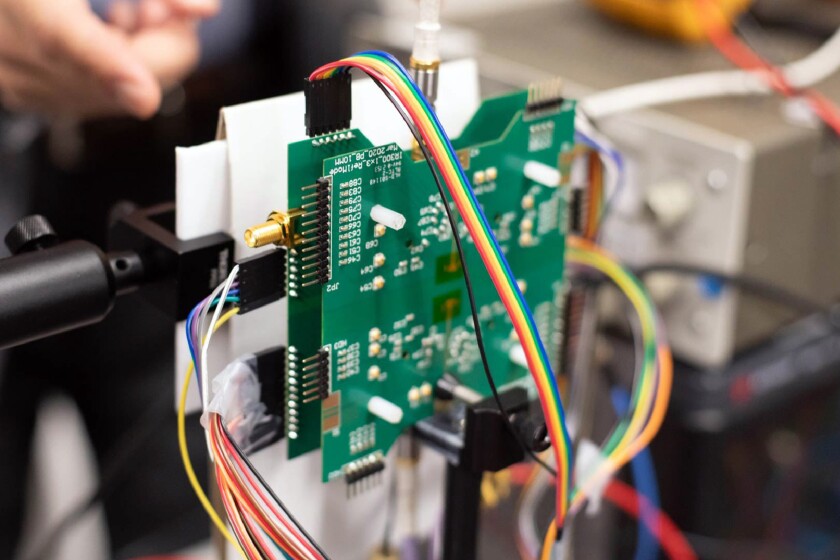Superman’s X-ray Vision Becomes Portable

UTD
Scientists have developed a miniature chip capable of capturing images of objects through cardboard. This technology, intended for integration into smartphones, moves us closer to emulating Superman’s ability to see through solid objects, without the need for X-rays.
Drawing inspiration from Superman’s X-ray vision, researchers from the University of Texas at Dallas (UTD) and Seoul National University (SNU) have advanced the ability to peer into packages and through walls. They achieved this by developing an imaging chip small enough to fit inside a smartphone.
Kenneth O, a co-author of the study and professor of electrical engineering at UTD, as well as director of the Texas Analog Center of Excellence (TxACE), likened this technology to Superman’s X-ray vision. However, they utilize signals ranging from 200 gigahertz to 400 gigahertz instead of X-rays, as the latter can pose potential harm.
In 2022, the imager microchip technology was unveiled, marking the culmination of over 15 years of research and development by O and his team, which included students, researchers, and collaborators.
Exploring the Safe and Unseen Frequencies
This chip emits radiation within the terahertz (THz) range, encompassing electromagnetic frequencies between 0.1 THz (100 GHz) and 10 THz, with corresponding wavelengths ranging from 3 mm down to 0.03 mm.
These waves, unseen by the human eye and considered safe, possess frequencies higher than radio waves and microwaves but lower than those of infrared light.
In the 2022 demonstration, O showcased how the microchip’s 430 GHz beams could traverse through fog, dust, and other obstructions that optical light cannot penetrate. Upon encountering objects, the beams reflected back to the microchip, where pixels captured the signals to form an image.
Unlike traditional methods reliant on external lenses to enhance image clarity and sharpness, this imager utilized complementary metal-oxide semiconductor (CMOS) technology, commonly employed in the production of modern consumer computer processors, memory chips, and digital devices.
CMOS has emerged as a cost-effective means to generate and detect THz signals, particularly in the frequency range of around 200 GHz and above, offering significantly improved resolution.
Thus, the researchers focused on refining the image quality of their 2022 model and miniaturizing the technology for handheld use. The new imager chip featured a 1 x 3 array of 296-GHz CMOS pixels and maintained its lens-less design.

UTD
Lens-Free Design for Mobile Compatibility
Wooyeol Choi, the paper’s corresponding author and assistant professor at SNU’s Department of Electrical and Computer Engineering, highlighted, “We designed the chip to be lens-free and optic-free for mobile device compatibility. The pixels, responsible for creating images by capturing reflected signals from target objects, are shaped like 0.5-mm squares, similar in size to a grain of sand.”
Safe Testing and Future Enhancements
The technology was tested successfully, capturing images of objects concealed by cardboard from a distance of about one centimeter (0.4 in). Maintaining this proximity was deliberate to ensure safety and privacy, preventing potential misuse such as scanning bag contents from afar.
The researchers aim to improve the technology to allow imaging from distances of up to five inches (12.7 cm).
In fact, Brian Ginsburg, director of radio frequency/millimeter wave and high-speed research at Texas Instruments (TI’s) Kilby Labs, highlighted, “It took 15 years of research to enhance pixel performance by 100 million times, along with digital signal processing techniques, to achieve this imaging breakthrough. This disruptive technology showcases the true potential of THz imaging.”
The researchers envision integrating their microchip imager into smartphones for various purposes, including detecting studs and wooden beams, identifying pipe cracks, and inspecting envelope and package contents, as well as potential medical applications.
To conclude, funding for the research came from the Texas Instruments (TI) Foundational Technology Research Program on Millimeter Wave and High-Frequency Microsystems and the Samsung Global Research Outreach Program.
Read the original article on: New Atlas
Read more: Development in Science is on The Decadence and We Are Unsure Why










